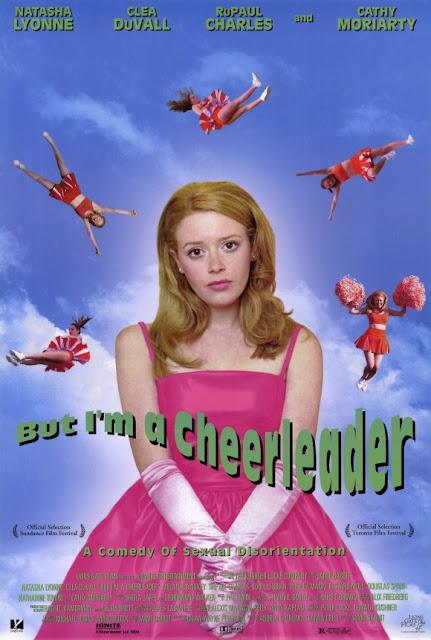 |
| Movie poster for But I’m a Cheerleader |
It takes an intervention and her parents’ sending her to a “pray away the gay” sort of camp, for Megan to realize she’s gay. Her family sends her to the camp “New Directions” hoping she’ll come back straight, but it only instills in Megan a certainty about her sexuality she hadn’t had before. Not only does she realize that being a lesbian is part of who she is, but through falling in love with another girl at the camp, Megan finds out that she doesn’t want to change it either.
This camp, by the way, looks like it came out of Tim Burton’s nightmares: brightly colored, celebrating conformity and bursting with perkiness.
The director of the camp, Mary Brown (Cathy Moriarty), “cures” homosexuality with a five-step-program. This program mostly involves making the collection of not-so-hetero teenagers act out their gender roles. The different campers are encouraged to find the root cause of their homosexuality – usually being a moment in their childhood where they witnessed adults deviating from gender norms. One’s mom wore pants at her wedding. Another’s mother let him play in pumps. Etcetera.
And so, Mary’s process is to push the adolescents into the cartoon versions of manhood and womanhood. The boys work with Mike (RuPaul) by playing football in solid blue uniforms, fixing a solid blue car and acting out war with solid blue weapons. The girls have their own solid pink version of this: changing baby doll’s diapers, cleaning house and painting nails.
But I’m a Cheerleader does fall into some traps. In portraying characters that are outrageous, there are lots of stereotypically flamboyant gay men. It’s less heinous than most portrayals in the mainstream, and seems to at least be trying to have a purpose. We see Mary’s son, Rock, in short shorts dancing around while ostensibly doing landscape work; living up to the most ridiculous and irritating gay stereotype. But, it’s supposed to be over-the-top to reveal the hypocrisy and absurdity of the camp. Also, while the film does a great job challenging the association of gender and sexuality, and presenting a gender spectrum, it doesn’t explore the spectrum of sexuality so much. Bisexuality is invisible.
But overall, the narrative is one that successfully challenges sexism and heteronormativity. Megan’s journey of falling in love and accepting herself looks normal compared to the antics of those who support the camp. It certainly feels more natural and provides a heart to the film that grounds it.
Megan’s romance with Graham (Clea DuVall) has the perfect combination of silly sweetness and teenage angst. While Graham accepts that she’s gay and is sure it is unchangeable, she is willing to stay in the closet to continue getting support from her family. When Graham and Megan are exposed – Megan leaves the camp, and Graham stays.
Reparative therapy has been the butt of many jokes, but it has existed and been validated by hack psychologists who contort research in an effort to prove that being gay is a mental illness. Robert L. Spitzer who published a study that suggested reparative therapy works, recently made an apology to the gay community because the study has been used to back up harmful methodology. But I’m a Cheerleader tackles an otherwise troubling topic, and makes it funny while still remaining critical.
In the film, while some characters make an effort to be straight, it seems clear that all understand it’s a role they are playing to appease their family. The futile effort could be their chance to remain a member of the community they grew up in. Megan knows that choosing to be open about her sexuality could lead to losing her family, but she chooses pride and oh-so-heroically rescues Graham from the altar of straightness (literally.)
But I’m a Cheerleader isn’t trying to be subtle. The absurdity of gender expectations is put on display with a too-bubbly soundtrack. Because: our society’s gender expectations are insane. And, it’s downright crazy to try to force an identity and sexuality on a person. But, But I’m a Cheerleader gives us a little hope at the end of a wacky lace-trimmed narrative. While the camp wasn’t exposed, while the girls weren’t guaranteed their families, Megan still performed a radical action in embracing both her identity as a lesbian and as a cheerleader. She challenged the expectations of her prescribed role, and still got the girl in the end.
———-
Erin Fenner is a legislative intern and blogger for Trust Women: advocating for the reproductive rights of women in conservative Midwestern states. She also writes for the Trust Women blog and manages their social media networks. She graduated from the University of Idaho with a B.S. in Journalism.

